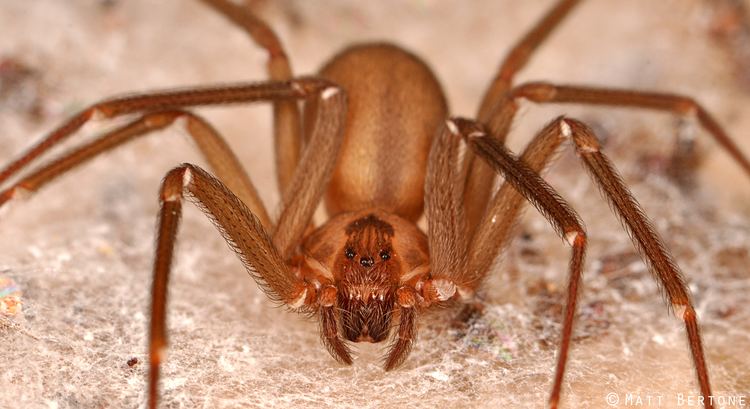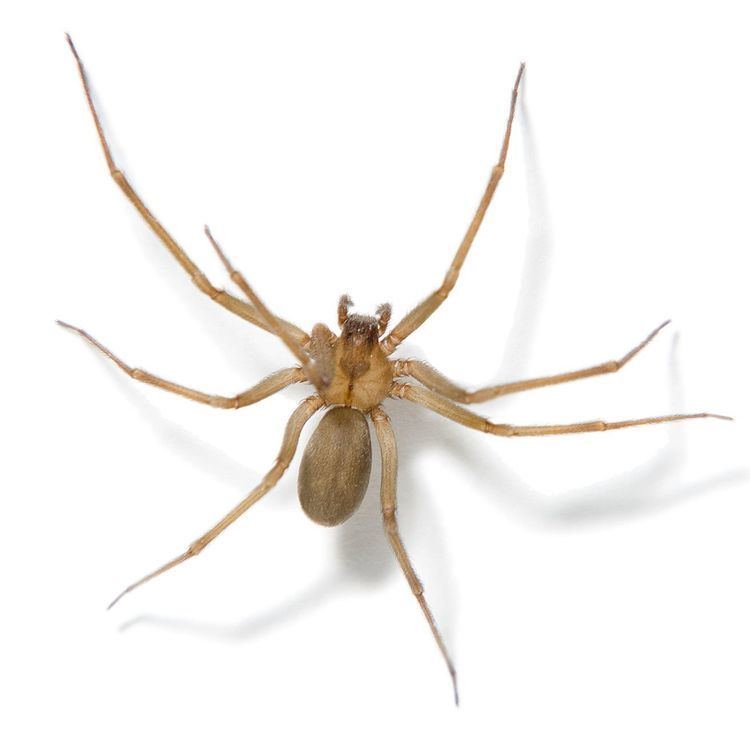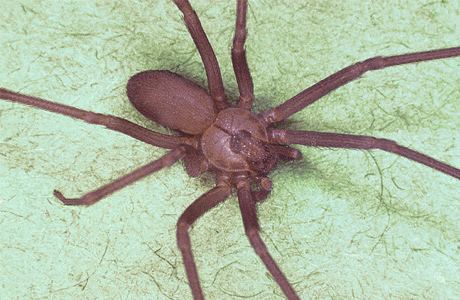Order Araneae Scientific name Loxosceles Clutch size Brown recluse spider: 50 | ||
 | ||
Genus LoxoscelesHeineken & Lowe, 1832 Length Brown recluse spider: 0.6 – 2 cm Lifespan Brown recluse spider: 1 – 2 years Lower classifications Brown recluse spider, Chilean recluse spider, Mediterranean recluse spider | ||
The recluse spiders or brown spiders, genus Loxosceles (/ˌlɒkˈsɒsᵻliz/), also known as fiddle-backs, violin spiders, or reapers, are a genus of venomous spiders known for their bite, which sometimes produces a characteristic set of symptoms known as loxoscelism. Recluse spiders are now identified as members of the family Sicariidae, having formerly been placed in their own family, the Loxoscelidae.
Contents
- Brown recluse spiders psa can you handle the truth
- Relation with other spiders
- Habitat and appearance
- Venom components and effects
- Species
- References

Brown recluse spiders psa can you handle the truth
Relation with other spiders
Sicariidae are of the superfamily Scytodoidea. Other families in the Scytodoidea include Drymusidae, Scytodidae, and Periegopidae.
Habitat and appearance
Loxosceles is distributed nearly worldwide in warmer areas. All have six eyes arranged in three groups of two (dyads) and some are brownish with a darker brown characteristic violin marking on the cephalothorax. However, the "violin marking" cannot be used as a reliable way to identify the spider as thousands of species of spider have similar markings. Spiders come with many markings varying greatly within the same species. Most Loxosceles can live for one and a half to two years. Members of both genera can live for very long times without food or water. They are about 7–12 mm long.

Familiar species in the United States include the brown recluse spider (Loxosceles reclusa). It is found in a large area of the Midwest, west to Colorado and the New Mexico state line and east to northern Georgia. Sporadic records from other locations only represent incidental introductions, not established populations. The brown recluse feeds on whatever small prey is available, and has been observed to prefer scavenging over actively hunting. Other notable members of this genus include the Chilean recluse spider (L. laeta) and the Mediterranean recluse spider (L. rufescens).

Recently, concerns have been raised regarding recluses spreading faster due to warmer air carrying them farther as a result of changing climate. On the contrary, newly hatched recluses do not travel via ballooning and thus the populations are confined to very tight spaces with dense populations.
Venom components and effects
Loxosceles spiders, like Sicarius species, have potent tissue-destroying venoms containing the dermonecrotic agent, sphingomyelinase D, which is otherwise found only in a few pathogenic bacteria. Recent research has indicated the venom is composed largely of sulfated nucleosides, though these compounds are relatively new discoveries, so little is known about them. The venom produces necrotic lesions that are slow to heal and may require skin grafts. Rarely, the venom is carried by the bloodstream to and cause red blood cell destruction.
The venom is identical in male and female spiders, but females can have almost twice the concentration of toxins. For unknown reasons, the toxicity of the venom to mammalian species varies; recluse bites may cause necrosis in humans, rabbits, and guinea pigs, but not in mice or rats.
The Chilean recluse (L. laeta) supposedly has a more potent venom, which results in systemic involvement more often. This spider was introduced to the Los Angeles area (Alhambra, Sierra Madre, and Monterey Park). No verified bites and the subsequent systemic hemolysis have been documented, even though it has been known there for over 30 years. All Loxosceles species that have been tested have venoms similar to that of the brown recluse and all should be avoided. In general, though, they are not aggressive and commonly occupy human dwellings without causing problems.
Many types of skin wounds are mistaken for or assumed to be the result of a recluse spider bite. Several diseases can mimic the lesions of the bite, including Lyme disease, various fungal and bacterial infections, and the first sore of syphilis. It is important to associate the spider directly with the bite to avoid improper treatment, and to successfully treat common infections or other conditions if no spider was seen.
Bites most often occur as a defense when the spider is trapped against the skin, in clothing, for example. Insecticides often fail to kill the spider, instead intoxicating its nervous system and inducing erratic behavior.
The bite of a recluse spider can generally be categorized into one of the following groups:
Most bites are unremarkable or mild.
Species
There are about 100 species of Loxosceles.
Species include:
